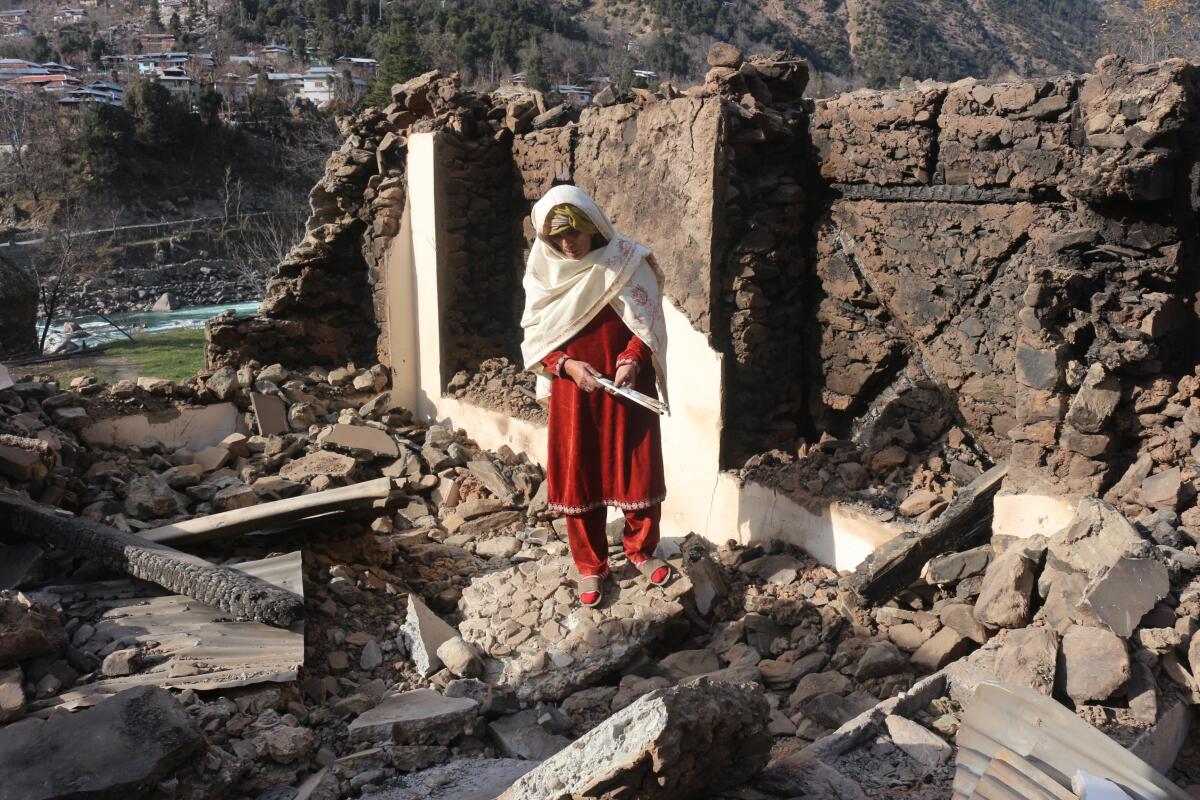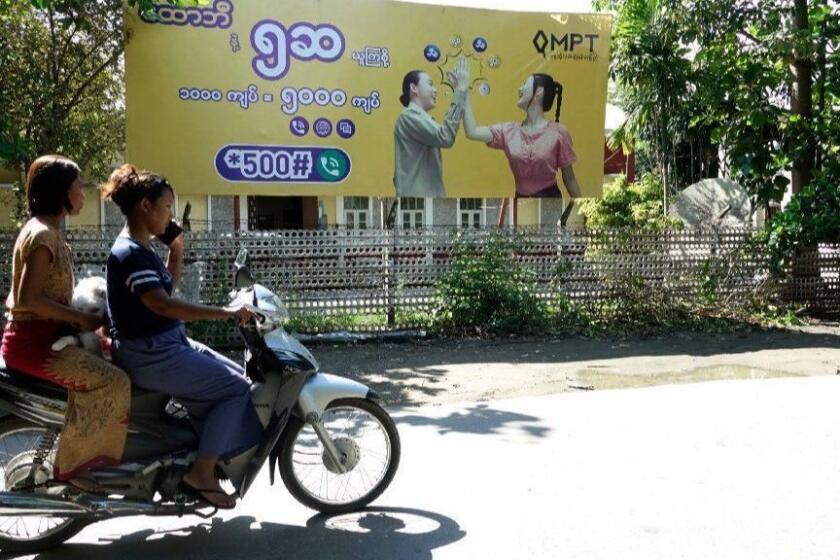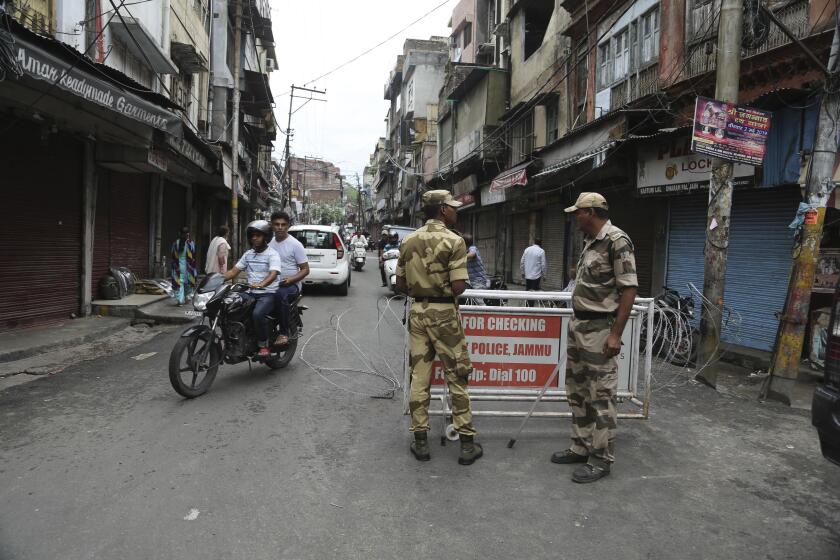Shelling spreads misery in Kashmir, caught between two nuclear rivals

- Share via
URI, India — A live mortar shell landed with a thud in the living room, though it did not explode.
Soraya Begum, a 48-year-old widow living in a hilly area along the Indian-Pakistani border, scooped up her 8-year-old son. She ran to a neighbor’s house as two more shells fell on her property, exploding in the dirt “like a mini-volcano” and forming 3-foot craters.
“It takes a few seconds for the shells to reach us once they are fired,” said Begum, who raises cattle for a living. “If you are lucky you manage to save yourself. Otherwise you die.”
Nearly 40 mortar shells fired by Pakistani troops fell in Begum’s village of Batgran on the afternoon of Oct. 13. The shelling was part of what residents and local officials describe as one of the most intense bursts of violence by the rival Pakistani and Indian militaries in years.
Shelling along the Line of Control — the de facto border dividing India and Pakistan in the disputed Himalayan territory of Kashmir — has grown markedly since August, when New Delhi revoked Kashmir’s limited autonomy and ended its status as a state, bringing it under the direct control of the Indian government.
The move was part of Indian Prime Minister Narendra Modi’s aggressive Hindu nationalist project, whose goals include taming the long-running separatist insurgency in the Indian-held portion of Kashmir, which had been the country’s only Muslim-majority state. India has blocked internet service across the territory for more than four months and detained all of Kashmir’s major political leaders.
For civilians in Myanmar’s Rakhine state — who have survived army-led massacres, violence by ethnic militias, restrictions on humanitarian aid and the forced displacement of hundreds of thousands of neighbors — life just got more difficult.
Pakistan administers another portion of Kashmir; the rival nations have fought three wars over the Himalayan region since gaining independence from Britain in 1947.
India and Pakistan have observed a cease-fire since 2003 along the 460-mile boundary, but the two armies routinely violate the truce by firing into the other’s territory, sometimes into inhabited villages.
India’s Defense Ministry said last month that it had recorded more than 950 cease-fire violations by Pakistani forces along the Line of Control since August, far more than in any three-month period since 2003. At least four soldiers and two civilians have been killed.
Pakistani officials say that 35 people, including eight security personnel, died when Indian forces fired weapons into the Pakistani-administered part of Kashmir.
In India, the shelling has been heaviest in Uri, an area that includes numerous mountain villages where, according to police, this year there have been 51 major Pakistani cease-fire violations — defined as ones where mortars and heavy artillery are employed — by far the most in any year since 2003. Of those cease-fire violations, 37 have come since the Indian home minister, Amit Shah, announced the revocation of Kashmir’s statehood on Aug. 5.
In Srinagar, Kashmir, the few residents who dare to break curfew beg soldiers to let them past checkpoints to reach hospitals or find food.
Indian authorities have not built any concrete bunkers in Uri as they have in other areas, so after nearly every major round of attacks, residents have been fleeing to villages and towns farther from the line of fire. Residents see this as a sign of callousness toward Kashmiris. Since 1998, 36 people in Uri have been killed in cross-border attacks.
Police in Uri say that since August, one civilian and one soldier have been killed and seven civilians injured in attacks blamed on Pakistani forces.
Residents say the attacks include mortar rounds as well as bursts of small-arms fire. Dozens of houses have been damaged or sprayed with bullets.
One of Begum’s neighbors, Shabir Ahmad Awan, 35, said he was cutting grass in his field Aug. 5 when he heard the first explosion. He ran into a barn where he remained for more than an hour, watching villagers duck behind rocks as mortar shells fell.
The rough terrain and hardscrabble agrarian life are now exacerbated by the increasing hostility between the two nuclear-armed neighbors. Many families have left their villages, some taking shelter with relatives farther from the border, others seeking refuge in the relative safety of the town of Uri.
“We do not want to go back to that hell,” said 52-year-old Mohammad Lateef Tarkhan, who fled after his mountaintop village of Churunda was hammered by artillery barrages from a nearby Pakistani military post.
He and three dozen other villagers have been given shelter in a school building about 12 miles away in Uri, 13 families huddling in two classrooms, each measuring about 360 square feet.
“This is not life,” he said. “We don’t live, we just survive.”
Seated in a semicircle on a classroom floor, some residents said their houses were destroyed by the shelling. Manzoor Ahmad said he took his wife and three children to his sister’s place on the other side of Churunda after shelling began one night in early November.
Early the next morning, he returned to his house and was stunned to see it had been reduced to rubble.
“When we left, we didn’t know where we were heading,“ Ahmad said. “We just wanted to leave that place. Imagine you are being fired upon from a distance of [about 110 yards], you wouldn’t even realize it until you’re dead.”
To guard against infiltration from Pakistan, the Indian army more than a decade ago fenced in Churunda with concertina wire — a barrier that was recently upgraded to a metallic mesh fence with thermal motion sensors. Only residents are allowed in and out of the village through a 10-foot-wide gate manned by Indian soldiers, heightening the residents’ feeling of isolation.
The night that shelling began in Churunda, Habibullah Mir’s house in Tilawari was abuzz with excitement over wedding ceremonies for his daughters Shahida and Salma, set for the next day. According to witnesses, during a traditional ceremony at which henna was being applied to the brides’ palms, a mortar shell fell 20 feet from the family’s house, sending guests scurrying into a cowshed in the back.
They huddled there for nearly two hours until the shelling stopped. One relative was struck by gunfire and underwent surgery. The next day, the weddings took place in simple, solemn ceremonies.
In Madian village a day before the Churunda attack, 19-year-old Ishtiyaq Ahmad was hit in the shoulder by a bullet fired from a Pakistani army post. Witnesses said he lay in a pool of blood for nearly two hours because other residents were too afraid to go to his aid.
“We were able to retrieve his dead body only after the shelling had completely stopped,” said Mohammad Yousuf Khan, the village chief.
Apple orchards are filled with spoiled fruit and half the crucial harvest is feared destroyed in a nearly three-month clampdown by New Delhi.
Villagers who have vacated their houses have pleaded with Indian authorities to defuse unexploded shells that they fear could cause further deaths or injuries. Riyaz Ahmad Malik, a local administration official, said the army has indicated it won’t be responsible for any damage to the houses.
“We are trying to find a way out and hopefully the problem will be solved soon,” Malik said.
Since leaving Batgran, Begum has been living with relatives in the village of Thajal, about three miles away, in a makeshift shed with a tin roof that offers little protection from the biting winter.
She was widowed when her husband died of natural causes in 2015. She lost a 10-year-old son to polio in 2017 and has struggled to raise her remaining three children, especially her 8-year-old son Tasleem Ahmad, who is also stricken with the illness.
Begum said she didn’t know when she could return to her village. Snow would soon cover Batgran, cutting it off from much of the outside world.
“At times,” she said, “I wish that shell had gone off and rid us of the kind of life we are living.”
Nanda is a special correspondent. Special correspondent Aoun Sahi in Islamabad, Pakistan, contributed to this report.
More to Read
Sign up for Essential California
The most important California stories and recommendations in your inbox every morning.
You may occasionally receive promotional content from the Los Angeles Times.
















